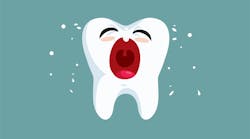Biolux Research announces publication of research paper on phototherapy and orthodontics
Biolux Research Ltd. is pleased to announce the publication of a new research paper in the European Journal of Orthodontics. The paper, titled “Resonance frequency analysis of orthodontic miniscrews subjected to light-emitting diode photobiomodulation therapy,” was published in December 2010. The principal investigator for the study was Dr. Enis Guray at the Department of Orthodontics, Faculty of Dentistry, Erciyes University, Kayseri, Turkey. Dr. Guray and his team have been investigating the effects of the Biolux OsseoPulse™ LED photobiomodulation (e.g., light treatment) device in various animal and human models for a range of orthodontic applications.
The study was based on evaluating the effects of Biolux LED light treatment on the stability of orthodontic miniscrews in an animal model. Miniscrews are temporary anchorage devices commonly used in orthodontics to provide a stable anchor point within the jaw structure, in order to apply additional forces in different directions and assist the orthodontist in achieving better control of tooth movement. Instability of miniscrews can lead to failure of the implant, loss of anchorage, and setback in the overall treatment plan.
In this study, 60 titanium miniscrews were implanted in the rabbit tibia, and then randomly divided into irradiated and non-irradiated (control) groups. Each group was then divided into three subsets, with different forces applied to each miniscrew. Post implant, the standard OsseoPulse™ device was used to irradiate each implant for 10 days, and implant stability was measured using resonance frequency analysis on days 0 and 21.
The results showed that all miniscrews had similar initial primary stability, and that non-irradiated control miniscrews decreased in stability post implant, which is typical for miniscrews and dental implants. For OsseoPulse-irradiated miniscrews, significant increase was found in stability levels for all three force levels, compared to day 0 stability.
“This new study demonstrates that our OsseoPulse technology can promote orthodontic miniscrew stability with a 10-day OsseoPulse treatment protocol,” states Peter Brawn, DDS, Biolux founder and chief scientific officer. “These results, along with our existing dossier of scientific and clinical papers and on-going studies, show that our Light Accelerated Regeneration technologies can have dramatic effects in improving the quality of implantology and orthodontic procedures while decreasing treatment timelines. We congratulate Dr. Guray and his team on the quality of their research, and look forward to further collaborations.”
Biolux Research Ltd. is a world leader in the development of innovative Light Accelerated Regeneration technologies and products for use in orthodontics, implantology, and other dentistry markets. Biolux focuses on phototherapy product development and clinical research, and its proprietary, patent-pending technologies have been developed to enhance clinical outcomes and dramatically reduce treatment timelines in dentistry in a safe, effective, and non-invasive approach.

